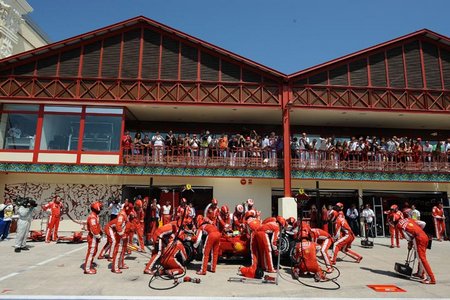With Ferrari set to unveil their 2009 challenger, the F2009, in Mugello today, Forumula1.com’s Dan Barnes explains why the team’s decision to re-instate their controversial pit light signal isn’t such a crazy idea after all.
As we eagerly anticipate the launch of the F2009 today, Ferrari have already reminded us of potentially the most contentious non-political aspect of the 2008 season: The Ferrari Pit Stop Lights!

Ferrari revealed last week that they intend to revert back to the pit stop light system, which triggered a litany of mistakes from the Scuderia during their championship campaign. Despite the lack of mistakes after Singapore, where Felipe Massa s race was ruined by a pit stop fiasco, I still feel it was a poor decision to remove the pit light from service.
There are a multitude of reasons why this was a poor call by Ferrari. The main reason is that the system was not actually at fault in any of the incidents.
Take Valencia, it was villanised twice: firstly, for Kimi Raikkonen s early release, which was actually the Finn jumping whilst the system was still on red, and for which he later accepted blame; and secondly for Massa s early release into Adrian Sutil as if we had never witnessed a poorly timed pit release from a lollipop man.
What transpired with Massa s pit stop was that the normally automated system, which prevents the light from turning to green before the fuel rig is detached, was switched into manual. In manual mode the fuel rig safety feature is deactivated so that when the GO button is pressed the light turns green irrespective of the fuel hoses position. The entire control of the pit stop was in the hands of a man who, instead of lifting a lollipop, like the rest of the teams, pressed a button to give a green light.
In Singapore the disastrous result was that Massa was given the green light before the fuel rig had been detached and subsequently lost the race. These were human errors made when the system was manually controlled and we have seen such similar incidents using the traditional lollipop. Over the years we have seen several examples of drivers being released early or jumping the gun on a pit release.
So we have established that the system was not at fault but the man controlling the system, when switched the lollipop mode was . To then replace a system which is used in 90% of pit stops – and worked faultlessly every time – with a system which relies 100% of the time on the same manual method,was utter madness. Most disturbingly was the re-introduction of a system which had not been practised in a competitive environment for over a year by Ferrari and which cost them the competitive edge the lights system brought in the first place. It was especially short-sighted considering the tracks left on the calendar; Japan, China and Brazil are not known for their safety car periods and therefore were unlikely to require the system to be used in its error prone fashion.
Ultimately all Ferrari needed to do was build in a few fail safes into the software which would of prevented any release of the car when the fuel hose is on for the manual mode, failsafe which Honda alluded to having in 2008 when they tested their own version of the pit light system. This begs the question: would Ferrari have made such oversights in 2008 with Ross Brawn still in control on the pit wall?
Regardless of its performance in 2008 I see the pit light system as the way forward from the clandestine and error prone lollipop man, not least because of the performance advantage but also for its reduction in errors and crowding of personnel around the car at a time of intense budget cuts.






